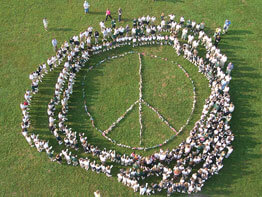Mother Seton School, Emmitsburg, students took part in the international fourth annual Pinwheels for Peace Sept. 22 by planting handmade pinwheels containing peace messages on the school lawn.
Last fall more than 1.2 million pinwheels were spinning in more than 2,500 locations around the world in this non-political project started by two Florida art teachers to give students an opportunity to express their feelings about circumstances in the world and in their community.
Peace doesn’t necessarily have to be associated with the conflict of war was the message reiterated to students – it can relate to violence and intolerance in daily life, and to peace of mind.
Local business and organizational leaders were presented with pinwheels for helping to spread peace throughout the community, and students were challenged to reach out to spread peace in school and in their lives.
“Peace begins by apologizing when you are in the wrong,” said Hayley Crum, a seventh-grader. “I can become a builder of peace by caring for people of other races – not judging them by the color of their skin or how they talk or look.”
Fifteen students from an environmental biology class at Loyola College in Maryland, Baltimore, began teaching biology to approximately 30 youth at The Club at Collington Square, an after-school program serving at-risk youth between 5 and 14 in east Baltimore. The Club is a program of Episcopal Community Services of Maryland.
Learning about water quality, plant life, and the function of ecosystems, the children will then conduct field studies in their neighborhood to better understand the importance of biology to their own lives. Field trips to Loyola later in the fall will give them the opportunity to work in a real laboratory.
Jennifer Scrafford of Loyola’s biology department said students will discover first-hand the power of the individual to initiate change. “My goal is … (for students) to gain a sense of their place in the natural world; and become ambassadors of change in their community.”
St. Francis of Assisi, Fulton, hosted The Little Bethlehem Christians, a group representing 170 Christian families who live in Bethlehem in the Holy Land and earn their living as wood carvers. Religious articles and olive wood were offered for sale after Masses Sept 27-28 by the Alsahouri family, members of the group, who circuit parishes in the archdiocese. Profits support Christianity in the land of Christ. Visit www.little-bethlehem.org for additional information.
Good Samaritan Hospital/Medstar, Baltimore, renamed its’ professional office building after the first chief of urology and one of its most generous contributors of time and financial resources. The Dr. J. Walter and Patricia K. Smyth Building was named after Dr. Smyth, a talented urologist and one of the first tenants of the building when it opened in 1983. Pat Smyth has been involved with the hospital since 1966 before it opened its doors, having served as chair of the board of directors, chair of the former Helix Health board, and the first chair of MedStar Health Board. She currently serves on the hospital’s foundation board. Mrs. Smyth has been a generous donor, and with other family members, has contributed a total of nearly $1.2 million.
Bishop Mitchell T. Rozanski blessed the new narthex at St. Clement Mary Hofbauer, Rosedale, Sept. 13. In addition to the gathering space, improvements include a new handicap lift and new air conditioning system. In the ceremony, Bishop Rozanski was assisted by Father Donald Grzymski, O.F.M. Conv., pastor.
News items for consideration in People, Places, Things should be emailed to ssingleton@catholicreview.org.


